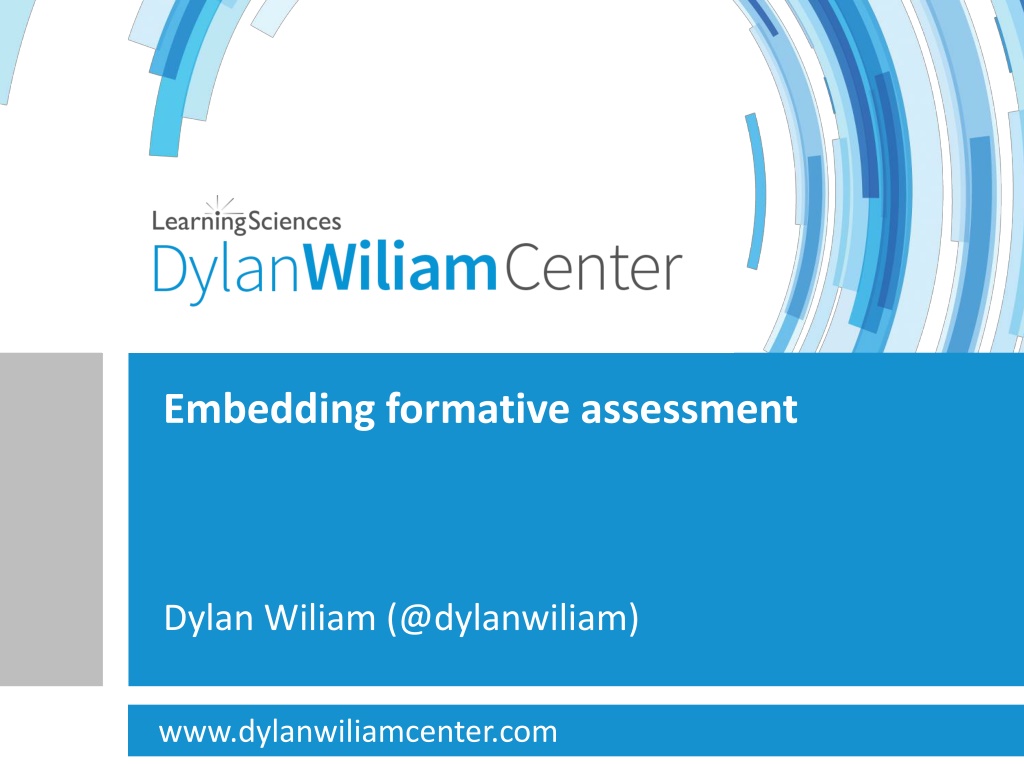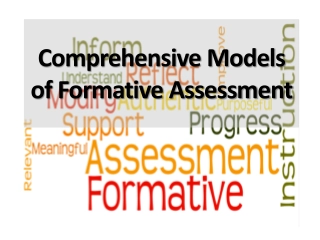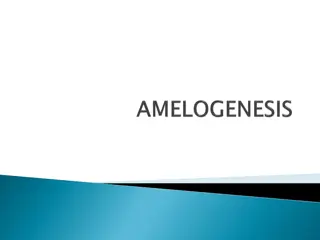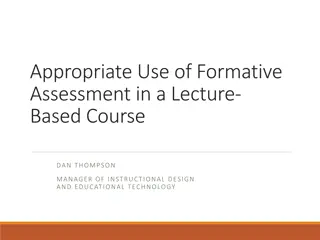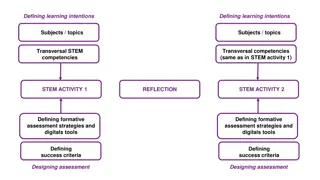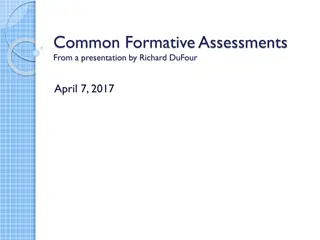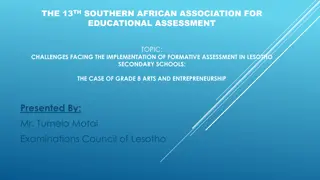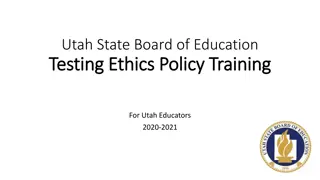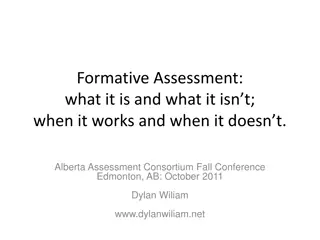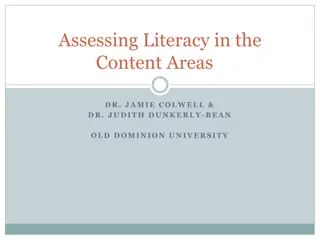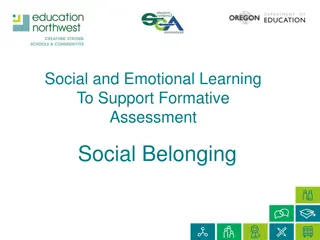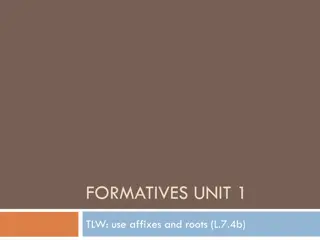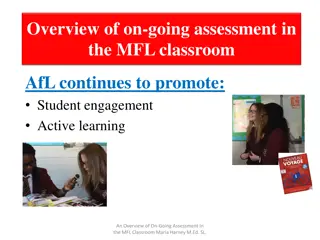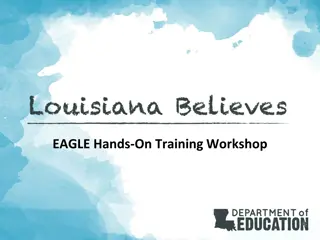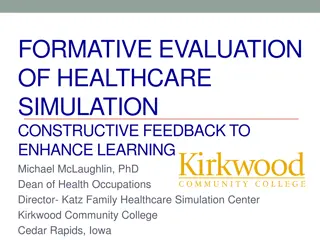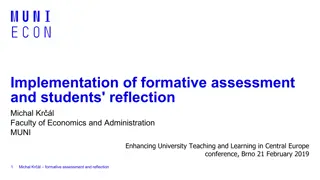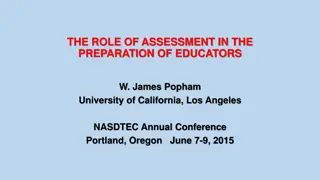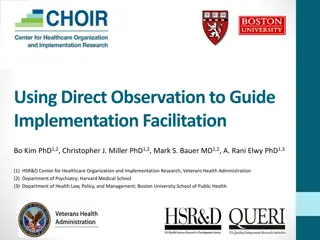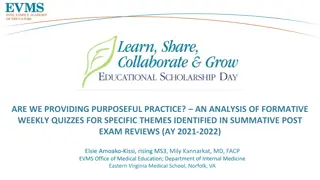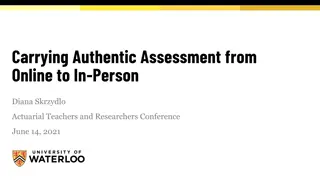Understanding Formative Assessment in Education
Exploring the significance of formative assessment in education through insights from renowned educators like Dylan Wiliam. Delve into the essence of learning, strategies for student achievement, and the need to prioritize formative assessment for effective teaching practices.
Download Presentation

Please find below an Image/Link to download the presentation.
The content on the website is provided AS IS for your information and personal use only. It may not be sold, licensed, or shared on other websites without obtaining consent from the author. Download presentation by click this link. If you encounter any issues during the download, it is possible that the publisher has removed the file from their server.
E N D
Presentation Transcript
Embedding formative assessment Dylan Wiliam (@dylanwiliam) www.dylanwiliamcenter.com
Learning and performance Alley maze experiments Hungry rats put in mazes Removed when they reach the food box Learning measured by number of entrances into blind alleys
Learning and performance Reinforcement None Regular Delayed 12 10 Average errors 8 6 4 2 0 0 2 4 6 8 10 12 14 16 Day Tolman and Honzik (1930) adapted by Sodestrom and Bjork (2015)
What is learning? 4 Learning is a change in long-term memory (Kirschner, Sweller, & Clark, 2016 p. 77) The aim of all instruction is to alter long-term memory. If nothing has changed in long-term memory, nothing has been learned. (ibid p. 77)
Where should our efforts be focused? 5 Which of these is most strongly associated with high student achievement? A. Student speaks the language of instruction at home B. Student behavior in the school is good C. The amount of inquiry-based instruction D. The amount of teacher-directed instruction E. The school s socio-economic profile Top 3 factors 1. Student s socio-economic profile 2. Index of adaptive instruction 3. The amount of teacher-directed instruction OECD (2016, Fig II.7.2)
6 Why formative assessment needs to be a priority
Why Formative Assessment? 7 A principle and an uncomfortable fact about the world The principle: "If I had to reduce all of educational psychology to just one principle, I would say this: The most important single factor influencing learning is what the learner already knows. Ascertain this and teach him [or her] accordingly (Ausubel, 1968 p. vi) The uncomfortable fact: Students do not learn what we teach. What is learning? Learning is a change in long-term memory (Kirschner et al., 2006) The fact that someone can do something now does not mean they will be able to do it in six weeks, but If they cannot do something now, it is highly unlikely they will be able to do it in six weeks
Relevant studies 9 Fuchs & Fuchs (1986) Natriello (1987) Crooks (1988) Bangert-Drowns et al. (1991) Dempster (1991, 1992) Elshout-Mohr (1994) Kluger & DeNisi (1996) Black & Wiliam (1998) Nyquist (2003) Allal & Lopez (2005) K ller (2005) Brookhart (2007) Wiliam (2007) Hattie & Timperley (2007) Shute (2008) Kingston & Nash (2011, 2015)
Formative assessment: A contested term 10 Long-cycle Medium-cycle Short-cycle Within and between teaching units Within and between lessons Across terms, teaching units Span Minute-by- minute and day-by-day Four weeks to one year One to four weeks Length Monitoring, curriculum alignment Student- involved assessment Engagement, responsiveness Impact
Unpacking formative assessment 11 Where the learner is going Where the learner is now How to get the learner there Providing feedback that moves learners forward Eliciting evidence of learning Teacher Clarifying, sharing, and understanding learning intentions Activating students as learning resources for one another Peer Activating students as owners of their own learning Student
Unpacking formative assessment 12 Where the learner is going Where the learner is now How to get the learner there Teacher Using evidence of achievement to adapt what happens in classrooms to meet learner needs Peer Student
13 Strategies and practical techniques for classroom formative assessment
14 Clarifying, sharing and understanding learning intentions
15 The indispensable conditions for improvement are that the student comes to hold a concept of quality roughly similar to that held by the teacher, is able to monitor continuously the quality of what is being produced during the act of production itself, and has a repertoire of alternative moves or strategies from which to draw at any given point. In other words, students have to be able to judge the quality of what they are producing and be able to regulate what they are doing during the doing of it. (Sadler, 1989 p. 121)
Memory on land and underwater 16 18 (5f, 13m) student members of a university diving club were tested on their recall of two- and three-syllable words from four 36-word lists taken from the Toronto Word Bank spoken to them twice. Students learned, and were tested on, the words while underwater, and while on the shore, resulting in four conditions: DD (learn dry, recall dry) DW (learn dry, recall wet) WD (learn wet, recall dry) WW (learn wet, recall wet)
Memory and context 17 Recall environment Dry Wet Dry 13.5 8.6 Learning environment 11.4 Wet 8.4 No significant main effects; interaction effect: F=22.0; df = 1, 12; p= <0.001 Godden and Baddeley (1975)
Alcohol and memory 32 adults (aged 22 to 43) asked to memorize a map and a 19- item set of instructions for a journey Half did so sober and half at the legal limit for intoxication The following day, half of them were tested sober and half at the legal limit for intoxication. Number of items correct Day 1 Day 2 Day 1: sober; day 2: sober 17 17 Day 1: sober; day 2: intoxicated 17 11 Day 1: intoxicated; day 2: sober 18 13 Day 1: intoxicated; day 2: intoxicated 16 16 Lowe (1981)
Share learning intentions 19 Keep the context out of the learning intention Differentiate success criteria, not learning intentions Process versus product success criteria Generic, not specific criteria Start with samples of work, rather than rubrics, to communicate quality Quality cannot always be reduced to words Ensure deep and surface features are not aligned Don t abdicate responsibility for quality Get students to generate their own tests
Question generation and learning 20 210 Introduction to Psychology students studied a 2,300 word text The work of being a bee Students prepared for a test given two days later One control group (left to their own devices) Six treatment groups Foos, Mora and Tkacz (1994)
Six treatment groups 21 Generated by Generated by Generated by Generated by Student Student Student Student Experimenter Experimenter Experimenter Experimenter Outline Outline Outline Generate an outline Generate an outline Generate an outline Given experimenter- Given experimenter- Given experimenter- generated outline generated outline generated outline Questions Questions Generate study Generate study questions questions Given experimenter- generated questions generated questions Given experimenter- Questions + answers Generate student questions with correct answers Given experimenter- generated questions and answers
Question generation and learning 22 210 Introduction to Psychology students studied a 2,300 word text The work of being a bee Students prepared for a test given two days later One control group (left to their own devices) Six treatment groups Four types of student-generated questions essay/fill-in-the-blank/multiple-choice/true-false 30-item test (15 multiple-choice, 15 fill-in-the blank) Items classified as target / non-target Foos, Mora and Tkacz (1994)
Test scores 23 Outline Questions Questions and answers 100% 90% 80% 70% 60% 50% 40% 30% 20% 10% 0% Experimenter Student Experimenter Student Non-target Target
Possible confounds 24 Student-generated material may have focused on material tested with easier items Experimenter-generated materials targeted more items, resulting in less time to study each item Retention intervals may have been shorter for students preparing their own materials All experimenter-generated study questions were essay questions, while some student-generated questions were not
Experiment 2 25 50 general psychology students from 2 US colleges Studied same text as experiment 1 for 30 minutes Half asked to generate study questions as they read Half given study questions generated by others
Experiment 2 results 26 Received Generated 100% 90% 86% 80% 70% 72% 60% 50% 54% 54% 40% 30% 20% 10% 0% Non-targeted items Targeted items Foos, Mora, and Tkacz (1994)
27 Engineering effective discussions, activities, and classroom tasks that elicit evidence of learning
Eliciting evidence 28 Two good reasons to ask a question To cause thinking To collect evidence to inform instruction No hands up (except to ask a question) Choose students at random No opting out Avoiding questions altogether
Alternatives to questioning Declarative statement Conservatives believe in privatisation But the Labour Party also believes in privatisation Reflective re-statement Labour, Conservative and Liberal Democrats believe in X So you re saying that all three major political parties believe in X Statement of mind X and Y seem contradictory. I don t see how you can believe in both Statement of interest I m interested in hearing a little more about X Student referral Your views contradict the views of the last speaker Teacher opinion That certainly has(n t) been my experience
Alternatives to questions Student questions speaker question Can you express your confusion in the form of a question? class question Does any one else have a question about what X has been saying? discussion question What kinds of questions should we be thinking about now Signals phatics & fillers pass (to another speaker) Silences deliberate non-deliberate Dillon (1988)
Eliciting evidence 31 Two good reasons to ask a question To cause thinking To collect evidence to inform instruction No hands up (except to ask a question) Choose students at random No opting out Avoiding questions altogether All-student response systems Decision-driven data collection Finger voting, dry erase boards, exit tickets Two kinds of questions Discussion questions Diagnostic questions
32 Eliciting evidence: Kinds of questions
Discussion questions: Science Ice-cubes are added to a glass of water. What happens to the level of the water as the ice-cubes melt? A. The level of the water drops B. The level of the water stays the same C. The level of the water increases D. You need more information to be sure
Discussion questions: History In which year did World War II begin? A. 1919 B. 1938 C. 1939 D. 1940 E. 1941
Diagnostic questions: Psychology 35 Which of the following is the most important difference between the theories of Piaget and Vygotsky? A. Piaget places greater importance on the role of conservation in cognitive development B. Vygotsky places greater importance on the role of cultural artifacts in cognitive development. C. Vygotsky did not believe in distinct stages of cognitive development. D. Piaget was a social constructivist while Vygotsky placed greater emphasis on cultural-historical activity theory
Developing good questions 36 1. Start by identifying a hinge-point in a lesson plan a point where you need to collect evidence from students in order to decide what to do next 2. Identify any relevant misconceptions a. by discussion with colleagues b. by asking the question as an exit-pass 3. Develop the question 4. Ask colleagues to look for possible false-positives 5. Trial the question with students, asking them to explain their choices
Cognitive rules Responses A Correct B Incorrect C D E 37
What makes a good hinge question? 38 Essential: 1. In no case do incorrect and correct cognitive rules lead to the same response Desirable (in order of priority): 1. Different incorrect cognitive rules lead to different responses 2. Different correct cognitive rules lead to different responses Two approaches to question writing Distractor-driven multiple-choice questions Multiple correct solutions
Multiple correct responses 39 20 cm What is the area of the semi-circle? 2 p 2 p 20 2 p 20 20 2 p 10 10 2 20 2 50p A. B. C. D. E.
40 Providing feedback that moves learners forward
Origins and antecedents 41 Feedback (Wiener, 1948) Developing range-finders for anti-aircraft guns Effective action requires a closed system within which Actions taken within the system are evaluated Evaluation of the actions leads to modification of future actions Two kinds of loops Positive (bad: leads to collapse or explosive growth) Negative (good: leads to stability) Feedback is information about the gap between the actual level and the reference level of a system parameter which is used to alter the gap in some way (Ramaprasad, 1983 p. 4) Feedback and instructional correctives (Bloom)
Discussion 42 Are the differences between how the term feedback is used in engineering and education important? How do you feel about the term feed-forward ?
Feedback in psychology 43 Feedback is any of the numerous procedures that are used to tell a learner if an instructional response is right or wrong (Kulhavy, 1977 p. 211) Key debate: confirmation vs. correction it is no surprise that scholars have worked overtime to fit the round peg of feedback into the square hole of reinforcement. Unfortunately, this stoic faith in feedback- as-reinforcement has all too often led researchers to overlook or disregard alternate explanations for their data. One does not have to look far for articles that devote themselves to explaining why their data failed to meet operant expectations rather than to trying to make sense out of what they found. (op cit. p. 213)
an evolving concept (Brookhart, 2007) 44 Conceptualization Information about the learning process that teachers can use for instructional decisions and students can use to improve performance which motivates students Source(s) Scriven (1967) Bloom, Hastings and Madaus (1971) Sadler (1983; 1989) Natriello (1987); Crooks (1988); Black and Wiliam (1998); Brookhart (1997)
Kinds of feedback (Nyquist, 2003) Weaker feedback only Knowledge of results (KoR) Feedback only KoR + clear goals or knowledge of correct results (KCR) Weak formative assessment KCR+ explanation (KCR+e) Moderate formative assessment (KCR+e) + specific actions for gap reduction Strong formative assessment (KCR+e) + activity
Effects of formative assessment (HE) Kind of feedback Count Effect Weaker feedback only 31 0.14 Feedback only 48 0.36 Weaker formative assessment 49 0.26 Moderate formative assessment 41 0.39 Strong formative assessment 16 0.56 Nyquist (2003)
Wise feedback: Study 1 44 7th grade students in 3 social studies classrooms Students wrote an essay about a personal hero Students received critical feedback plus a note Control: I m giving you these comments so that you ll have feedback on your paper. Treatment: I m giving you these comments because I have very high expectations and I know that you can reach them. Double-blind RCT design Students given a week to resubmit Yeager, Purdie-Vaughns, Garcia, Apfel, Brzustoski, Master, Hessert, Williams, & Cohen (2014)
Student revisions Control Treatment 100% 90% 87% 80% Percent revising essay 70% 72% 60% 62% 50% 40% 30% 20% 17% 10% 0% White African-American Students
Wise feedback: Study 2 Same as study 1, except Different students Students are required to resubmit essays
Impact on achievement Control Treatment 14 12 12.21 Score on revised essay 11.91 11.25 10 9.45 8 6 4 2 0 White African-American Students
